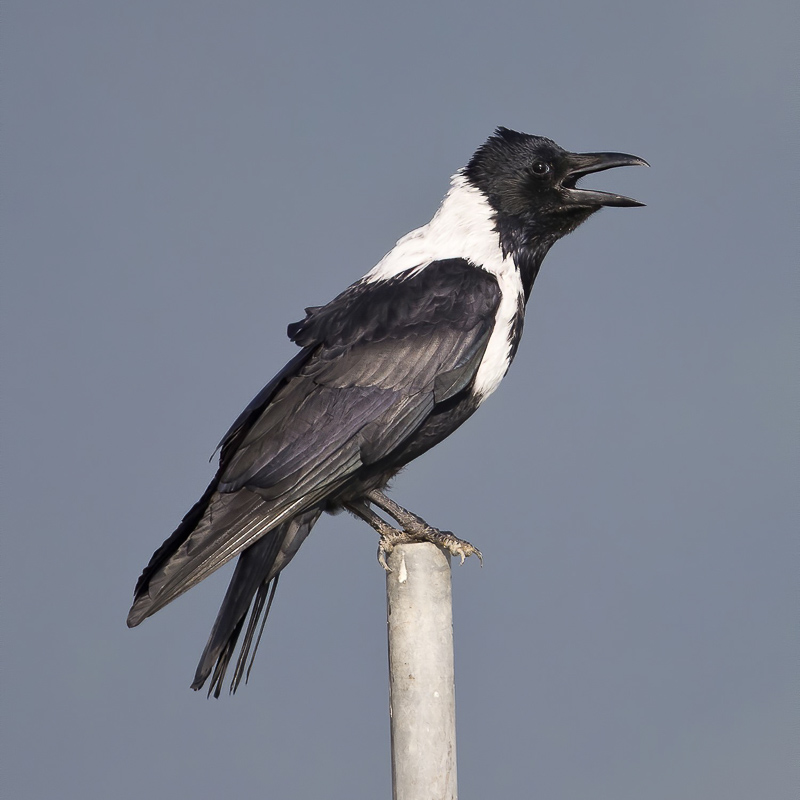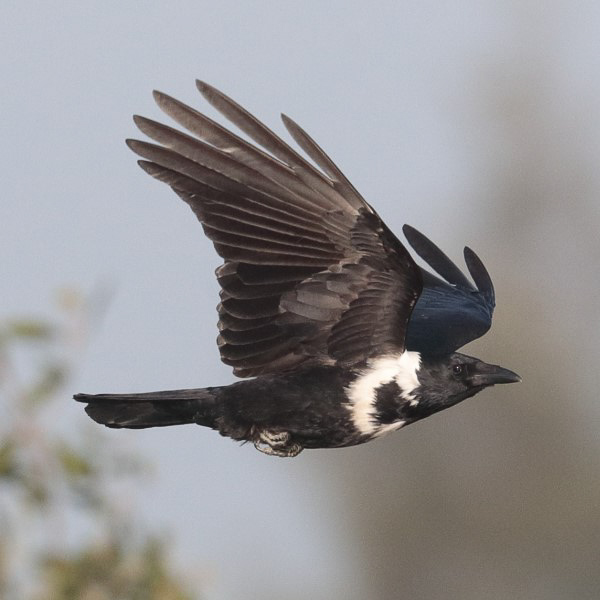Collared Crow Corvus torquatus 白頸鴉
Category I. Localised resident in lowland and coastal areas. Hong Kong supports an important part of the global population, particularly the large communal roosts at Mai Po Nature Reserve and Shuen Wan Landfill.
IDENTIFICATION

Sep. 2013, Martin Hale. Adult.
50-55 cm. A large black corvid with a prominent whitish band on hindneck, mantle and sides of neck to breast. Bill is black and slender, and legs are black. Sexes are very similar. Juvenile birds have a looser, softer plumage with white areas washed grey.

Nov. 2020, John and Jemi Holmes.
In flight appears more lightly built than Large-billed Crow.
VOCALISATIONS
Higher pitcher ‘kaaarr’ than Large-billed Crow. The territorial call is 3-4 notes repeated in succession, and each may be shorter in duration than other notes, and possibly also an obvious diphthong.
Other calls uttered in flight or while perched tend to be slightly more drawn out.
DISTRIBUTION & HABITAT PREFERENCE
Locally common in lowland and coastal areas with strongholds in Deep Bay and Tolo Harbour where it is typically recorded from rocky and sandy shores, mudflats, gei wai and fish ponds.
Away from these areas it occurs in low densities, usually along rocky coastlines at such places as Lamma Island, Tung Lung Chau, Green Island and Sai Kung. It can also be found in urban locations around Victoria Harbour (e.g., Quarry Bay, Kai Tak and Tseung Kwan O) and Tolo Harbour. Largely absent from Lantau.
Swinhoe (1861) stated that it was common, and Herklots (1953) considered it to be widespread. He listed records from Lam Tsuen, an inland site where it no longer occurs, and referred to a nest near Aberdeen on HK Island as well as regular reports from Pok Fu Lam, but regular reports from these areas ceased by around 1970. Herklots (1967) noted that it was now present at fewer localities than formerly, though Chalmers (1986) considered that it largely replaced the Large-billed Crow in the Deep Bay area and the northern New Territories. Although there are relatively more of the latter species in the Deep Bay area today, no direct link between the changes in the relative numbers of the two species has been demonstrated (Carey et al. 2001)
Between the breeding bird surveys of 1993-96 and 2016-19 there was an increase in the percentage of squares in which the species was recorded from 3.3% to 3.6%. Similarly, there was an increase between the winter atlas surveys of 2001-05 and 2016-19 from 4.5% to 6.5%. In both surveys, however, the species appeared to be under-recorded in its known range. It was recorded from 38 of 106 5km squares surveys in Leader et al. (2016). In both atlas surveys it was recorded in widespread areas of HK with a similar broad distribution.
OCCURRENCE
There are two significant roosts, one in the mangroves at Mai Po NR and the second in trees fringing Tolo Harbour at Shuen Wan. At these roosts, numbers are consistently higher in the mid to late summer period than the preceding winter period; this is assumed to be due to the recruitment of young birds following breeding activity. Seasonal fluctuations in the number of individuals joining roosts are usual amongst communally roosting corvids, increasing in early summer and falling during autumn; it is presumed the drop in winter numbers is a result of natural mortality. At the MPNR roost, it appears that additional Collared Crows may join the roost later in the summer, although it is unclear where these birds come from as the species seems to be rare in south China (Leader et al. 2016) and local birds are apparently accounted for.
Routine monitoring of the MPNR communal roost since 2004 (WWF-HK unpub. data) recorded a peak summer count of 261 individuals (2018) and 225 in winter (2018-19). However, roost numbers appear to have declined in recent years, with peak summer and winter counts in 2021-22, of 120 and 82 individuals respectively. The reason for this decline is not known and requires further investigation.
The Mai Po population of Collared Crows includes a large proportion of non-breeding birds of between 49−91%. It cannot be assumed that the non-breeding population of Collared Crows at Mai Po consists only of immature birds, as potential breeding birds may be present, but their activity constrained by the fact that the Deep Bay area does not appear have the capacity for additional breeding pairs.
Six years of monitoring data of the communal roost site at Shuen Wan Landfill in the period 2011-2019 indicated the Tolo Harbour population was relatively stable at an annual summer maximum of 104-117 birds in years in which more than one summer count was made (Lewthwaite 2019). The highest count at this site was 127 on 27 July 2021 (after the period reported in Lewthwaite 2019). Lowest numbers occurred in January and February 2019 when 31-39 birds were counted.
BREEDING
Courtship and nest-building commence from mid-November to December. Nests are built of small branches, mud and grasses in the forks of trees, and are often well hidden in dense stands of woody vegetation (e.g., fung shui woodland, intertidal mangal or plantation woodland), although occasionally nests have been recorded on open, isolated trees.
Eggs (up to five) are laid from the end of December but usually in late February and March. They are light olive blotched with dark olive or greenish-brown, sometimes entirely masking the ground colour (Herklots 1967). Young usually fledge between February and May and can be seen in small family parties after leaving the nest.
BEHAVIOUR, FORAGING & DIET
Similar to other corvids, Collared Crows form pre-roost gatherings, typically in open areas. At Mai Po NR they usually use bare tree branches or bare or sparsely vegetated islands and bunds, while at Shuen Wan Landfill they utilise open grassland. Both locations are conspicuous from the air. Numbers increase in the period before sunset and birds depart to roost as a flock well after sunset, settling at the roost on average 22.4 ± 9.3 minutes after sunset (Leader et al. 2016). The trigger for the final movement to roost is not known. Immediately prior to roosting, birds become vocal with constant movement and jostling by small groups between trees.
The Deep Bay communal roost is in the intertidal mangrove at Mai Po NR, while the Shuen Wan Landfill population roost in exotic plantation trees surrounding a golf driving range and adjacent to Tolo Harbour. Prior to leaving the communal roost at MPNR, one or more of the flock emerge to either a tree top or onto the border fence to keep watch. Acting as sentinels, these crows will call frequently, with calling becoming more intense as the flock emerges and disperses. Nesting birds are also very vocal, often performing a bowing display along with a territorial 'song'.
Observations in other areas of HK reveal this species is present in lower densities (singles or pairs/small family parties). Individuals have been observed in pre-roosts of Large-billed Crow in Aberdeen Country Park, where Collared Crow is seen infrequently. Large-billed Crow, House Crow, Daurian Jackdaw, Rook, Carrion Crow and Oriental Magpie have also occasionally been recorded at the Mai Po NR pre-roosts.
Scavenges carrion, dead fish and shellfish, and has been observed feeding on snakes (e.g., Checkered Keelback Xenochrophis piscator).
RANGE & SYSTEMATICS
Found mainly in China, where it is resident in lowland central, east and southeast China from south Gansu and Shaanxi east to Liaoning, Hebei and Shandong and south to Sichuan, Yunnan, Hainan, Guangdong, and Fujian (including Kinmen, off the Fujian coast); it occurs rarely in spring in Beijing. Also present in north Vietnam (lowland east Tonkin south to central Annam) (Madge 2020, Birding Beijing 2022).
The Dabie Shan in central China (Henan, Hubei and Anhui) is the most important area for the species, supporting about 30% of the total population, followed by HK which supports 20% (Leader et al. 2016).
CONSERVATION STATUS
IUCN: VULNERABLE. Population trend decreasing due to agricultural intensification. Collared Crow is one of the few species of conservation importance occurring in HK for which conservation action taken in the SAR could have a meaningful impact on the global population.
Birding Beijing (2022). https://birdingbeijing.com/the-status-of-the-birds-of-beijing/ (Accessed 24 May 2024).
BirdLife International. (2018). Corvus pectoralis. The IUCN Red List of Threatened Species 2018: e.T22706049A131735892. https://dx.doi.org/10.2305/IUCN.UK.2018-2.RLTS.T22706049A131735892.en. Accessed on 25 April 2022.
Carey, G.J., Chalmers, M.L., Diskin, D.A., Kennerley, P.R., Leader, P.J., Leven, M.R., Lewthwaite, R.W., Melville, D.S., Turnbull, M. and Young, L. (2001). The Avifauna of Hong Kong. Hong Kong Bird Watching Society, Hong Kong.
Chalmers, M. L. (1986. Annotated Checklist of the Birds of Hong Kong. Hong Kong Birdwatching Society, Hong Kong.
Herklots, G.A.C. (1967). Hong Kong Birds (2nd ed.). South China Morning Post, Hong Kong.
Leader, P. J., Martinez, J., Stanton, D. J. & Lewthwaite, R. W. (2016) A review of the distribution and population size of Collared Crow Corvus torquatus. Forktail 32: 41–53.
Lewthwaite, R. W. (2019). Pre-roost gatherings of Collared Crow Corvus torquatus at Shuen Wan Landfill. Hong Kong Bird Report 2017: 328-328.
Madge, S. (2020). Collared Crow (Corvus pectoralis), version 1.0. In Birds of the World (J. del Hoyo, A. Elliott, J. Sargatal, D. A. Christie, and E. de Juana, Editors). Cornell Lab of Ornithology, Ithaca, NY, USA. https://doi.org/10.2173/bow.colcro1.01
Stanton, D. J., Smith, B. R. and Leung K. K. S. (2014) Status and roosting characteristics of Collared Crow Corvus torquatus at the Mai Po Nature Reserve, Hong Kong. Forktail 30: 79–83.
Stanton, D. J. (2017) Notes on the Collared Crow Corvus torquatus population structure at Mai Po Nature Reserve, Hong Kong. BirdingASIA 24: 43-46.
Swinhoe, R. (1861). Notes on the ornithology of Hong Kong, Macao and Canton, made during the latter end of February, March April and the beginning of May 1860. Ibis 1861: 23-57.

